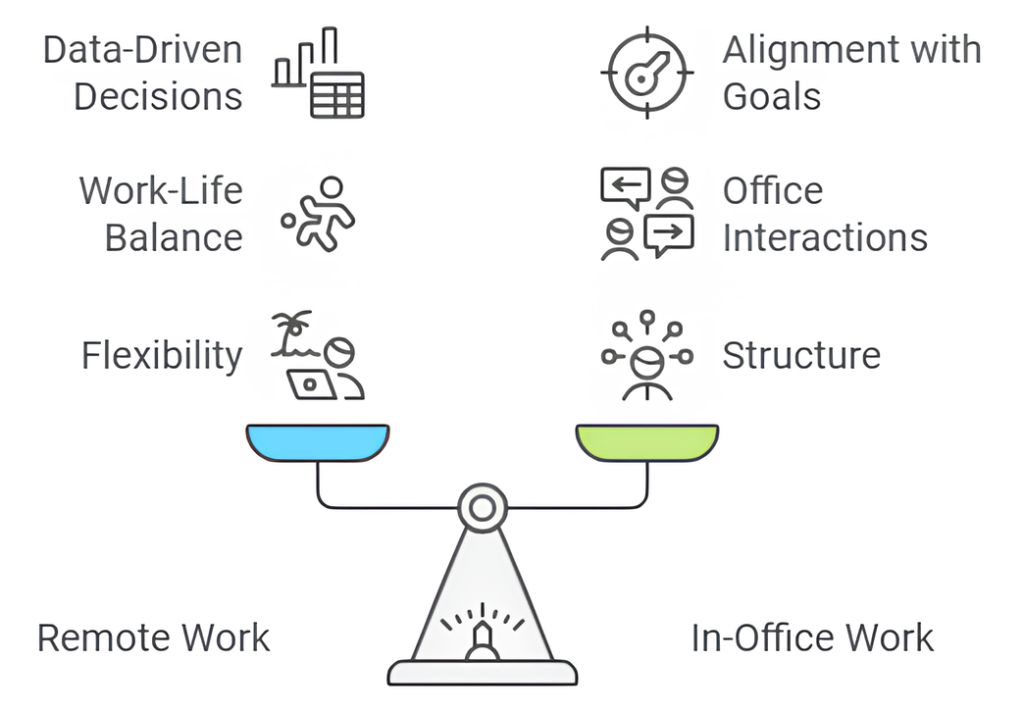The concept of “work” has drastically changed in recent years. Traditional office spaces, filled with activity from 9 to 5, have given way to living rooms, cafes, and co-working spaces. Remote work, once considered a perk, is now a defining feature of modern business. Alongside it, hybrid models have emerged as a compromise, blending the best of in-office and remote work. But what does this shift mean for businesses, employees, and the future of work itself?
Let’s dive into how businesses are evolving to meet the demands of this new normal, the opportunities it presents, and the challenges that lie ahead.
The Remote Work Revolution
The rise of remote work began long before global disruptions made it a necessity. For years, advancements in technology have enabled companies to experiment with remote work policies. However, the Covid-19 accelerated this trend exponentially, forcing organizations to switch almost overnight.
Why Working Remotely Works:
- Flexibility: Employees can set their schedules, improving work-life balance.
- Global Talent Pool: Companies can hire from anywhere, expanding access to skilled workers.
- Cost Savings: Businesses save on office spaces, utilities, and other overheads.
- Productivity Gains: Many employees report being more productive when working from home.
Data backs up this trend. A report by Gartner found that 82% of company leaders plan to allow remote work at least part of the time post-pandemic.

The Rise of Hybrid Work
While fully remote setups work for some, others find value in the balance provided by hybrid work models. These models combine remote work with in-office days, offering flexibility while maintaining a sense of team bonding.
Benefits of Hybrid Models:
- Flexibility: Employees can choose the work environment that best suits their tasks.
- Team Building: In-office days foster collaboration, innovation, and social interaction.
- Cost Management: Businesses can reduce office space requirements without going fully remote.
- Improved Morale: Employees appreciate having control over where and how they work.
Major corporations like Apple, Google, and Microsoft have implemented hybrid models, setting industry benchmarks. Smaller companies are also following suit, recognizing the importance of offering employees a choice.

The Challenges of Remote and Hybrid Work
The shift to remote and hybrid models isn’t without its difficulties. For many businesses, adapting to these changes requires overcoming significant hurdles:
- Communication Barriers: Maintaining clear and consistent communication across remote teams can be tricky and difficult.
- Technology Dependence: Businesses need reliable tools for collaboration, task management, and virtual meetings.
- Employee Engagement: Remote workers often feel disconnected, making engagement and team culture a challenge.
- Cybersecurity Risks: With employees accessing sensitive information from various locations, ensuring security is critical.
- Work-Life Balance Issues: While flexibility is a perk, it can blur the lines between personal and professional lives.
To combat these challenges, companies are investing in robust communication platforms, cybersecurity solutions, and virtual team-building initiatives.

Industries Adapting the Remote Work Model
Not every industry can adopt remote work, but many have embraced it successfully.
Here are some sectors growing in the remote environment:
- Tech and IT: Companies like Shopify and Twitter have shifted to remote-first models.
- Education: Online learning platforms have transformed the education industry.
- Customer Support: Remote call centers are becoming the norm.
- Media and Marketing: Creative agencies now rely heavily on remote collaboration tools.
- Healthcare: Telemedicine is growing rapidly, making healthcare more accessible.
These industries demonstrate how adaptable businesses can be, leveraging remote work as a competitive advantage.

The Role of Technology in Remote and Hybrid Work
Technology is the backbone of remote and hybrid work. Without it, this shift wouldn’t be possible. From collaboration tools like Slack and Microsoft Teams to project management platforms like Asana and Trello, technology keeps remote teams connected and productive.
Additionally, advancements in AI and automation are further streamlining workflows, allowing businesses to maintain efficiency and stay competitive.
Future Trends in Remote Work Technology:
- Virtual reality (VR) meetings to enhance collaboration.
- AI-driven performance tracking tools.
- Advanced cybersecurity protocols to protect data.

The Future of Remote Work
So, is remote work here to stay? While some experts argue that traditional offices will make a comeback, most experts believe remote and hybrid work models will dominate the future.
Key Predictions:
- Increased Flexibility: More companies will adopt “work from anywhere” policies.
- Focus on Results: Businesses will prioritize outcomes over hours worked.
- Enhanced Employee Well-being: Organizations will invest in mental health resources and ergonomic tools.
- Sustainability Goals: Remote work reduces carbon footprints by cutting down commuting.
Ultimately, businesses that embrace this shift and adapt their strategies will thrive in the new normal.

Image Source: [StockCake]
Conclusion
Remote and hybrid work models are not just trends; they represent a profound transformation in how we work. By leveraging technology, addressing challenges, and adapting flexibility, businesses can unlock new levels of productivity, innovation, and employee satisfaction.
As we move forward, one thing is clear: the future of work is dynamic, and businesses must continue to evolve to stay ahead. Whether fully remote, hybrid, or traditional, the key lies in adaptability and a willingness to accept change.













One Response